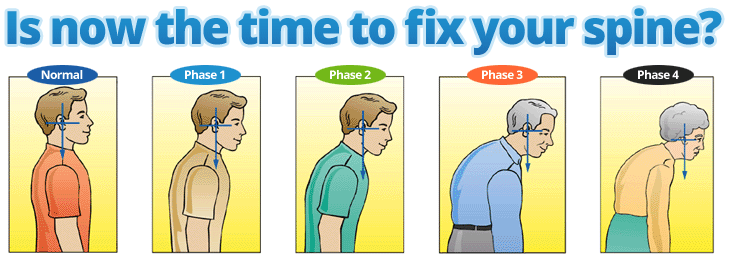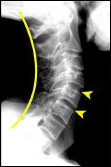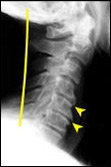Spinal Care
If you don’t practice Dental Care, you can live without your teeth. BUT, if you don’t practice Spinal Care, you cannot live without your spine!
If you don’t practice Dental Care, you can live without your teeth. BUT, if you don’t practice Spinal Care, you cannot live without your spine!

Many years ago, before the advent of orthodontics, crowded adult teeth causing pain and swelling were simply pulled out. Now we have the knowledge and ability to make room for crowded teeth by reshaping the mouth and straightening the teeth. Of course it takes more time and money to save teeth than pull them but we’ve found it generally wiser to preserve than to waste. This is especially true of joints and discs in the neck and back. Since the spine is made of movable bones that house the central nervous system and allows us freedom of movement, degeneration here leads to years of painful stiff misery and poor health. If your spine has lost its normal shape and the joints in your neck or back are abnormally compressed, locked or misaligned, the discs between the bones may have already started to decay. (Please see x-rays below) Valuable correction time should never be wasted. Where the spine is concerned we must save rather than waste.
With Relief Care, some joint compression, muscle tension and nerve pressure can be relieved and most people feel better fast. However, the application of Relief Care is similar to inflating a tire with a leak. the damaged tire may be useful temporarily but will always require re-inflation. Further, the tire’s leak is a structural weakness, a warning that it may fail unexpectedly. While Relief Care is an extremely valuable tool, it cannot reshape abnormal areas of the spine that cause disc tissue to wear away and spinal joints to become stiff, painful and arthritic. Think of Relief Care as temporarily relieving the pain and swelling caused by teeth that have grown too tightly together; but without straightening the teeth and reshaping the mouth as the orthodontist would.
Corrective Care is a modern, advanced form of chiropractic treatment designed to realign twisted joints while simultaneously restoring the neck and back to their natural curved shapes. It requires detailed geometric spinal analysis and a specially trained doctor. With Corrective Care you and your doctor working as a team can improve the motion, function and longevity of your spine by decompressing, unlocking and reshaping it. Think of Corrective Care as orthodontics of the spine without the braces. Unfortunately many patients have allowed their spines to deteriorate to the point that Corrective Care is not possible with current technology. However, for those patients where Corrective Care is still an option, the extra time, money and effort they spend now may help them avoid an early road to aging, years of hunched, stiff, painful posture and potential spinal surgery.
While Corrective Care in your case may not take the 2 to 4 years required to straighten teeth, it does require patient participation, especially with home care appliances and exercise. To straighten teeth and reshape the mouth, orthodontists apply pressure-over-time. Forcing the teeth in a desired direction over a prolonged period of time is what changes the alignment and shape of the mouth. Similarly, the doctor of chiropractic utilizes special equipment like the Posture Pump® to lift, decompress and reshape the spine. The Posture Pump® is a home care appliance that inflates the neck and back into their proper curved shapes, applying pressure-over-time.
 If you were asked how much you should pay the dentist you would rightfully inquire as to the extent of services you would be receiving. You would of course expect to pay more to have your teeth straightened than to fix a toothache. Since there is limited insurance coverage for orthodontics, most patients finance their care or pay cash. The cost of Corrective Spinal Care will vary from case to case depending on its severity and length of treatment anticipated by the treating doctor. As an RN (registered nurse), I have worked in the emergency room and outpatient surgical units for over 15 years. I am continually amazed at the number and variety of people who choose to have expensive elective procedures not covered by insurance. For example, breast augmentations $7,000 plus, tummy tucks $9,000 plus, lipo-suction $4,000 plus, lip injections for that fuller look $2,000 plus, botox injections over $500 every 3 months and the list goes on. I have found that in most cases if a patient feels it is important enough, the finances can be worked out.
If you were asked how much you should pay the dentist you would rightfully inquire as to the extent of services you would be receiving. You would of course expect to pay more to have your teeth straightened than to fix a toothache. Since there is limited insurance coverage for orthodontics, most patients finance their care or pay cash. The cost of Corrective Spinal Care will vary from case to case depending on its severity and length of treatment anticipated by the treating doctor. As an RN (registered nurse), I have worked in the emergency room and outpatient surgical units for over 15 years. I am continually amazed at the number and variety of people who choose to have expensive elective procedures not covered by insurance. For example, breast augmentations $7,000 plus, tummy tucks $9,000 plus, lipo-suction $4,000 plus, lip injections for that fuller look $2,000 plus, botox injections over $500 every 3 months and the list goes on. I have found that in most cases if a patient feels it is important enough, the finances can be worked out.
Fixing a toothache may take a day and cost hundreds, while having your teeth straightened takes years and costs thousands. Is having your spine corrected and preserved worth as much as having your teeth straightened? You better believe it. Not hundreds but thousands of dollars alone in surgical prevention! Furthermore, stiffness and hunched posture is what makes even young people look and feel old. Premature aging of the neck and back will always occur when the spine buckles forward or is locked to one side. People notice. Again, as a registered nurse, I have all too often seen the chronic use of painkillers and muscle relaxants destroy relationships and productive lives while hiding progressive spinal disease. My vote is for prevention and correction.
If a health care professional provided this information to you, he or she probably offers both Relief Care and Corrective Care.

75-year-old patient (#8202) with normal curve. Can you see the wide disc spaces between the bones? (see arrows) A curved shape in the neck and back allows the weight to be evenly distributed on the joints. Even at 75-years-old this person has freedom of movement without pain and stiffness. Note the curved shape of this spine compared to the one opposite. (See curved line here and straight-line on opposite
x-ray)

55-year-old patient (#6184) Note that the curve is missing! Can you see how thin the disc spaces become when the curve is lost? (See Arrows) As weight bears forward, compressing the joints, soft discs between the bones dry out and die. Can you notice the bones deforming in shape and taking on a melting candle appearance? Even though this patient is much younger than the one opposite advanced decay has set in. Valuable correction time has been lost and years of painful stiff misery loom ahead. (See joint decay at arrows and compare with opposite x-ray)